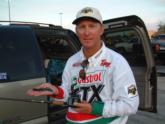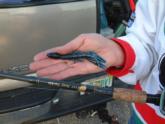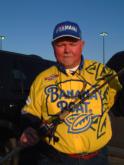Florida’s flipping fanatics revealed

If wintertime bass fishing on Lake Okeechobee could be put into some kind of mathematical equation, it might look something like this:
((OKEECHOBEE + COLD FRONT) – WATER TEMPERATURE) X FISHING PRESSURE = FLIPPING.
Okay, so maybe that is not the exact formula, but after last week’s Wal-Mart FLW Tour event on Lake Okeechobee, there is little doubt that flipping is an effective technique for catching Okeechobee’s frigid water bass.
Pat Fisher of Buford, Ga., won the event flipping, and at least seven other of the top 10 finalists were also flipping thick mats of vegetation.
In fact, before the FLW, the EverStart and BASS events were also won with this unique flipping technique.
So what is this “flipping?”
Flipping in Florida is like a local religion for a handful of dedicated followers. Ocala, Fla., is an apparent hot spot for this flipping sect. FLW Outdoors anglers Billy Bowen, Glenn Browne and Rick Couch from Ocala are all proficient at flipping thick mats with heavy baits and stout rods.
 Further down the state, Mike Surman of Boca Raton, Fla., could be considered a high priest of the long-pole doctrine. He has logged thousands of hours on the Big O punching holes through thick mats of vegetation with a 1-ounce sinker. Surman won the very first FLW event on Lake Okeechobee in 1996 by flipping mats in cold-front conditions.
Further down the state, Mike Surman of Boca Raton, Fla., could be considered a high priest of the long-pole doctrine. He has logged thousands of hours on the Big O punching holes through thick mats of vegetation with a 1-ounce sinker. Surman won the very first FLW event on Lake Okeechobee in 1996 by flipping mats in cold-front conditions.
Surman is also part owner of the Gambler Bait Company, which manufactures several items specifically designed for flipping.
The equipment
For starters, the equipment used for the flipping technique is extreme: 7 1/2- to 8-foot flipping sticks are a standard.
Preferred line types and sizes vary from 80-pound-test braided line to a minimum of 25-pound-test monofilament.
The terminal end consists of a magnum bullet weight of at least 1 ounce. One of Surman’s specialty items at Gambler is a screw-in type sinker called a “Florida Rig,” which screws into plastic baits.
Another popular weight that proves an angler’s dedication to the flipping allegiance is called a Penetrator Weight. The weight is made from tungsten in sizes that exceed 1 ounce.
For a hook, many top Florida flippers prefer a straight shank hook made from thick-gauge steel such as Gamakatsu’s Superline or Owner’s 3X. Surman prefers a Tru-Turn hook because of the large barb.
 “Some of the other hooks have small barbs,” Surman notes. “They penetrate good, but when the fish starts really thrashing under that stuff, I think they can get off.”
“Some of the other hooks have small barbs,” Surman notes. “They penetrate good, but when the fish starts really thrashing under that stuff, I think they can get off.”
When it comes to baits, all of the Okeechobee flipping kingpins use some kind of plastic crawdad. Though preferences of craw brands vary among anglers, the anglers do seem to agree that the more compact the plastic craw is, the better.
Glenn Browne, who led the Everstart event after two days by flipping, prefers the Allen Lures Fireclaw, a well-known Florida flipping bait. Surman designed the Gambler Crawdaddy specifically for flipping.
Are they really trying to imitate a crawdad when flipping?
Maybe not. As one angler said this week, “You just need a hunk of plastic to hold that big weight and hook together; it doesn’t matter what it is.”
The technique
Surman describes flipping in Florida as an art.
“Just because a guy is a good flipper in Arkansas or Missouri does not mean he is a good flipper in Florida,” Surman says. “Just as an angler from Missouri knows how to read a willow bush to make the right flip, I know how to read a mat of vegetation to make the right flip. There is an art to flipping these mats; there are subtle, but very distinct patterns within those mats.”
Andy Morgan of Dayton, Tenn., who is a flipping legend in his part of the country, even admits that Florida flipping is different.
“I was here in 1996 when Surman won that FLW by flipping mats,” Morgan recalls. “I went to school on it then and it is different. It’s like flipping grass and you have to know what to look for – the smallest things make the biggest difference. With a lake this big, it’s hard to slow down enough to flip a mat and learn those subtleties because there is so much other stuff to fish.”
But Morgan has proved that you don’t have to be a Florida native to master Florida flipping. Morgan not only won the EverStart event on Okeechobee, but he finished fourth in the FLW by flipping as well.
To call this style of fishing “flipping” is a bit of a misnomer. The terms “punching,” “shimmying” and “wrenching” might serve well to better describe flipping on Okeechobee.
First anglers have to get their bait through thick, impenetrable mats of floating vegetation – hence the big weight. Some anglers pitch their bait high up into the air to let it get enough momentum to “punch” through the mat on the way down. Other anglers pitch the bait onto the mat and shake the bait until it “shimmies” down into a hole.
 Billy Bowen, a well-known Florida flipper who finished eighth in the FLW, says the technique takes a lot of patience.
Billy Bowen, a well-known Florida flipper who finished eighth in the FLW, says the technique takes a lot of patience.
“I try to pitch to small `water spots’ in the tight mats of hyacinths,” he describes. “If I miss, I’ll shake the bait towards the hole to get it to go through. When the flipping bite is really on, they grab it as soon as it pops through the mat. When the bite is tough, like it was in the FLW, you have to let that bait sit on the bottom for a long time – sometimes a minute. Once I get a few bites I can key in on the overall aggressiveness of the fish and adjust my presentation accordingly.”
So where is the excitement of heaving a 1-ounce sinker into mats that are dense enough to hold up large birds? That’s where the “wrenching” comes in.
Wrestling 5- to 10-pound bass out of these mats with a rod and reel is a real thrill. It’s like fighting a grouper in 2 feet of vegetative slop.
But if you can barely get an ounce of lead through the mat with gravity on your side, how do you get a 7-pound bass out?
“Surprisingly they come out pretty easy,” Bowen says. “When they start thrashing, they kind of wallow out a big hole and just come out flopping on top of the mat. Then you drag them in. Actually, it is easier to get a 7-pounder out than a 2-pounder because the big fish throws so much water they create their own hole.”
Surman says he sometimes has to pin the fish up against the “roof” of the mat with steady pressure on the rod. Then he cranks up the outboard, guns his boat into the mat and literally digs the fish out.
Both Surman and Bowen say that it is a combination of cold weather and fishing pressure that position Okeechobee’s big bass under the floating mats.
“I think it has more to do with fishing pressure,” says Surman. “The fish use those mats all year long, but the flipping bite has always been best on the weekends when boats are running all over the lake.”
“It is a little of both,” Bowen surmises. “The pressure is definitely a factor, but these cold fronts help send them under the mats, too.”